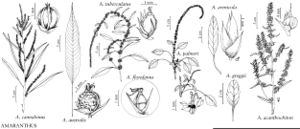Amaranthus palmeri
Proc. Amer. Acad. Arts 12: 274. 1877.
Plants glabrous or nearly so. Stems erect, branched, usually (0.3–)0.5–1.5(–3) m; proximal branches often ascending. Leaves: long-petiolate; blade obovate or rhombic-obovate to elliptic proximally, sometimes lanceolate distally, 1.5–7 × 1–3.5 cm, base broadly to narrowly cuneate, margins entire, plane, apex subobtuse to acute, usually with terminal mucro. Inflorescences terminal, linear spikes to panicles, usually drooping, occasionally erect, especially when young, with few axillary clusters, uninterrupted or interrupted in proximal part of plant. Bracts: of pistillate flowers with long-excurrent midrib, 4–6 mm, longer than tepals, apex acuminate or mucronulate; of staminate flowers, 4 mm, equaling or longer than outer tepals, apex long-acuminate. Pistillate flowers: tepals 1.7–3.8 mm, apex acuminate, mucronulate; style branches spreading; stigmas 2(–3). Staminate flowers: tepals 5, unequal, 2–4 mm, apex acute; inner tepals with prominent midrib excurrent as rigid spine, apex long-acuminate or mucronulate; stamens 5. Utricles tan to brown, occasionally reddish brown, obovoid to subglobose, 1.5–2 mm, shorter than tepals, at maturity walls thin, almost smooth or indistinctly rugose. Seeds dark reddish brown to brown, 1–1.2 mm diam., shiny.
Phenology: Flowering summer–fall, occasionally spring–winter in southern part of its native range.
Habitat: Streambanks, disturbed habitats, especially agricultural fields, railroads, waste areas, roadsides
Elevation: 100-1000 m
Distribution
Ont., Ariz., Ark., Calif., Colo., Fla., Ga., Ill., Kans., Ky., La., Md., Mass., Miss., Mo., Nebr., Nev., N.J., N.Mex., N.Y., N.C., Ohio, Okla., Pa., S.C., Tenn., Tex., Utah, Va., W.Va., Wis., Mexico, introduced Europe, Asia, and Australia.
Discussion
Originally native to the North American Southwest, from southern California to Texas and northern Mexico, Amaranthus palmeri at present is a successful invasive species, which is evident from its expansion both in eastern North America and overseas. Because of its rapid spread, the distribution data presented here are probably incomplete.
Selected References
None.
